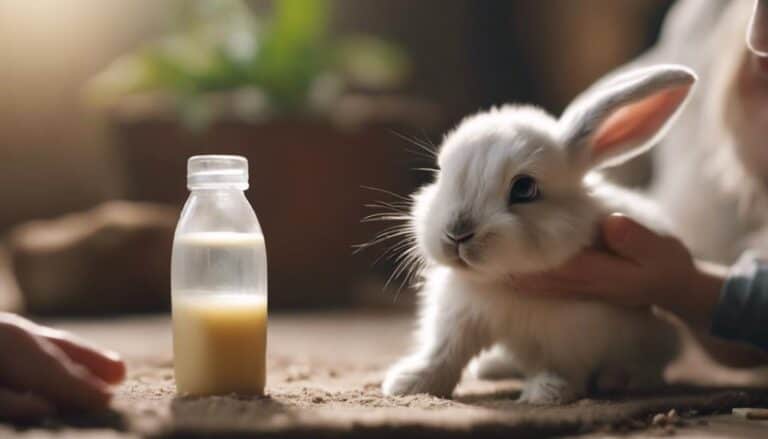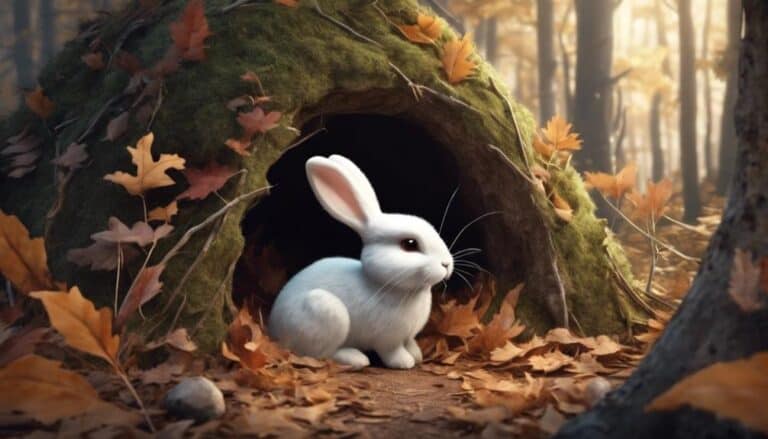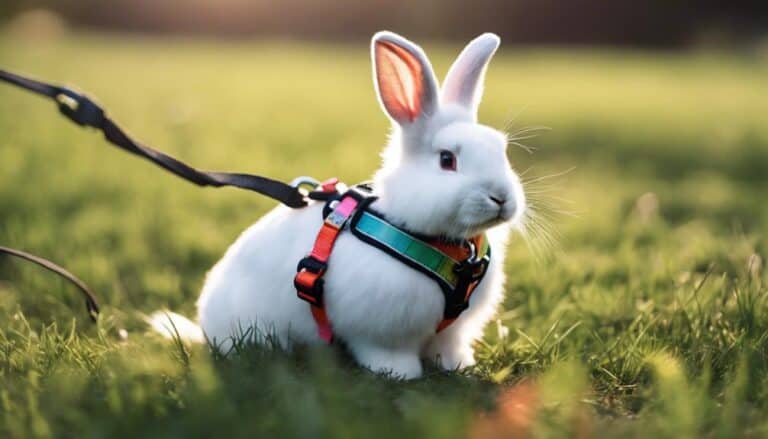So, you're wondering if cats and rabbits can really be friends? The answer might surprise you. Despite being very different in terms of size and behavior, these two animals have the potential to form a special bond that goes beyond just putting up with each other.
Their instincts and personalities are key to understanding how they can get along. Cats are natural predators, while rabbits are prey animals. This means that, in the wild, they'd be on opposite sides of the food chain.
However, in a domestic setting, we can create an environment where they can coexist peacefully. To make this work, it's crucial to provide a safe space for both animals. This means giving them separate areas where they can eat, sleep, and relax without feeling threatened or territorial.
Supervised interactions are also essential, allowing them to get used to each other's presence and scents. As they spend more time together, you might be surprised by the unique bond that forms between them. They might even start to play, groom, or simply hang out together.
This friendship can enrich their lives in ways you never thought possible. So, how do these unlikely companions navigate their relationship? Let's dive into the fascinating dynamics between cats and rabbits and uncover the secrets to their harmonious coexistence.
Contents
- 1 Key Takeaways
- 2 Benefits of Cat and Rabbit Friendship
- 3 Understanding Prey-Predator Dynamics
- 4 Establishing Safe Coexistence
- 5 Importance of Proper Supervision
- 6 Mutual Grooming and Cuddling
- 7 Addressing Individual Personalities
- 8 Setting Boundaries for Positive Interactions
- 9 Enriching Lives Through Companionship
- 10 Conclusion
Key Takeaways
So, can cats and rabbits really be friends with each other? The answer is yes, but it requires some effort on your part. With proper introduction and supervision, cats and rabbits can develop a strong bond.
One of the ways to strengthen their friendship is through mutual grooming and play. It's amazing to see how these natural enemies can become so comfortable with each other. However, it's essential to understand the prey-predator dynamics at play here. You need to be aware of the instincts that drive your cat's behavior and make sure your rabbit feels safe.
Each cat and rabbit is different, so it's crucial to understand their individual personalities. Some cats might be more aggressive, while some rabbits might be more timid. By recognizing these traits, you can establish safe coexistence by providing separate spaces and setting boundaries.
The key to a harmonious relationship is observing the behavior of both pets and offering positive reinforcement. Reward them with treats and praise when they behave nicely towards each other. With patience, love, and care, your cat and rabbit can become the best of friends.
Benefits of Cat and Rabbit Friendship
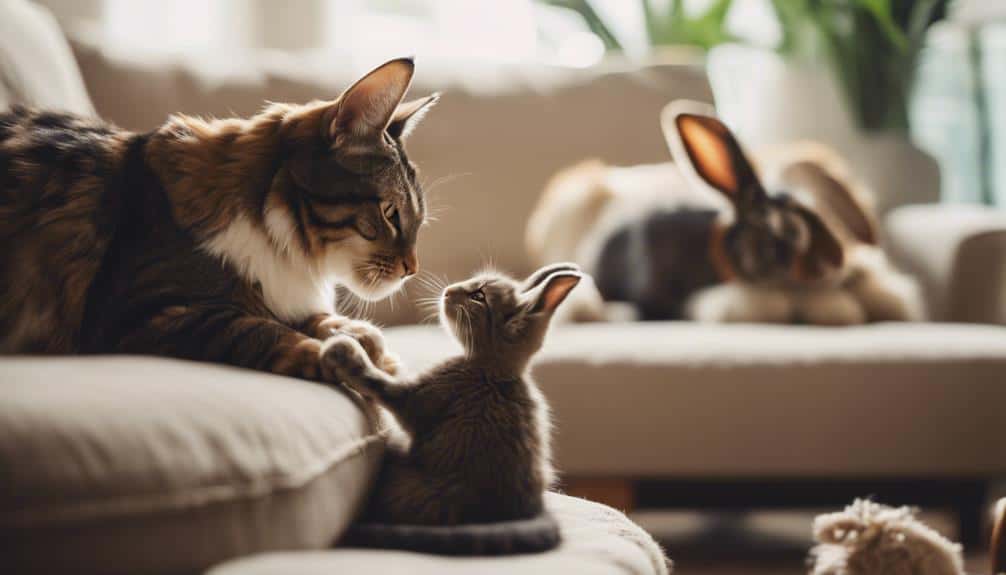
So, you're wondering about the benefits of having a cat and a rabbit as friends in the same household. Well, it's definitely possible, and it can be super beneficial for both of them.
First of all, it's essential to understand that cats have a strong prey drive, which means they might see rabbits as potential prey. But, with the right introduction, they can learn to live together peacefully. You'll want to choose a cat with a low prey drive, one that's been socialized around other animals.
Then, introduce them slowly in a controlled environment, so they can get used to each other.
When you do it right, the friendship between a cat and a rabbit can be really special. They can keep each other company, play together, and even groom each other.
It's not uncommon to see them cuddle up together, which is pretty adorable. This friendship can bring a lot of joy to both the cat and the rabbit, making their lives more interesting and fun.
Understanding Prey-Predator Dynamics
When you're thinking about how cats and rabbits interact, you need to remember that they've natural instincts that can't be ignored. Cats are predators, and it's in their nature to chase and catch prey. Rabbits, on the other hand, are prey animals that have developed a strong sense of awareness to detect potential threats like cats.
This instinctual response in rabbits can cause them a lot of stress and anxiety when they're around cats. Rabbits have a natural instinct to flee or defend themselves when they sense a predator, which can create a tricky situation when you pair them with cats.
Cats might see rabbits as something to play with or chase, which can lead to the cat pouncing or chasing the rabbit, potentially harming it.
Rabbits also have a very keen sense of smell, which means they can detect the scent of a cat even if it's not right there. This can make them even more fearful and anxious.
To create a safe and peaceful environment for both cats and rabbits, it's essential to understand these predator-prey dynamics.
Establishing Safe Coexistence
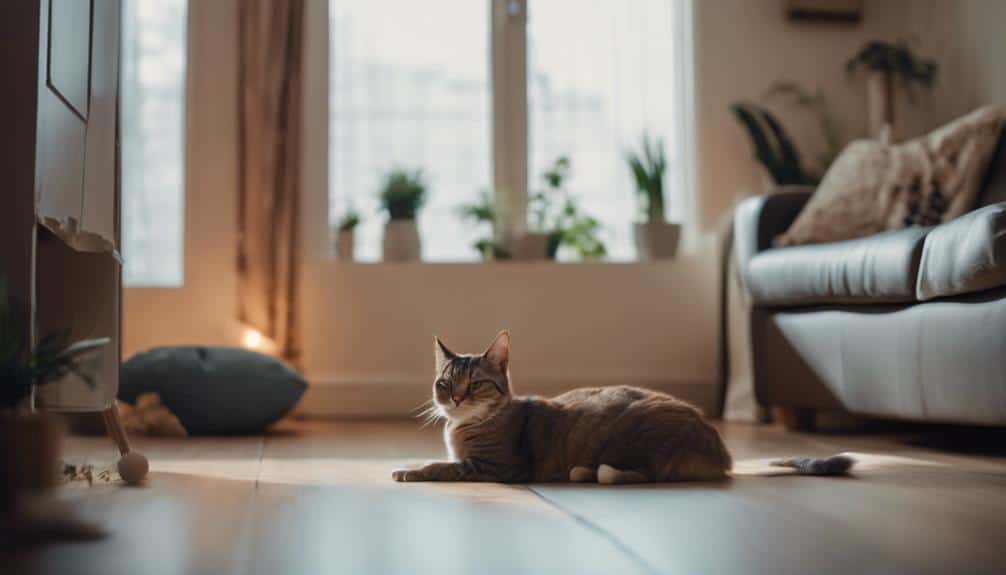
So you've got a cat and a rabbit living together, and you want to make sure they get along safely.
The key is to give each pet their own space and territory. This way, they can feel comfortable and relaxed in their own little zones.
When you first introduce them to each other, make sure to supervise their interactions closely.
This will help prevent any conflicts or stress.
It's also important to understand the behavioral cues of both your cat and rabbit.
Space Sharing Tips
So, you want to make sure your cat and rabbit can live together in harmony?
The key to success is giving them their own space. When you bring a cat into a home with a rabbit, it's essential to provide each pet with their own designated area.
Cats are naturally curious, and they might see rabbits as prey. So, it's a good idea to offer a hiding place for the rabbit where the cat can't get to it.
This will help reduce stress when they're first living together. The hiding place should be secure and safe for the rabbit to retreat to if needed.
When you're introducing your cat and rabbit to each other, try swapping their bedding or toys to help them get used to each other's scents.
This can help them feel more comfortable with each other and create a sense of familiarity. Another idea is to use baby gates or pet barriers to set boundaries between their territories while they adjust to sharing the same space.
Supervised Interactions Necessary
So you want to keep your cat and rabbit from fighting, right? The key to this is supervising their interactions from the very start. You see, cats have this natural instinct to hunt, and rabbits can get pretty scared around them.
So, when you first introduce them, make sure you're watching closely to prevent any conflicts.
When you're supervising their interactions, pay attention to their body language. If either the cat or rabbit looks aggressive or fearful, separate them right away.
You want to create a safe space where both animals feel comfortable. This means giving your rabbit some hiding spots and making sure your cat can’t corner or bully them. In addition to providing hiding spots, it’s essential to supervise their interactions, especially during the initial stages of their introduction. Familiarize yourself with some effective female rabbits cohabitation tips, such as introducing them slowly and allowing them to sniff and observe each other from a distance before any direct contact. This gradual approach can help both pets adjust to one another’s presence, ensuring a harmonious living environment in your home.
With patience and careful supervision, your cat and rabbit can actually become great friends.
Just remember, their safety and well-being should always be your top priority when they're interacting.
Behavioral Cues Understanding
Understanding the behavioral cues of both your cat and rabbit is crucial for them to live together safely. Since rabbits are prey animals, they might react differently to certain stimuli.
When you're watching them interact, remember that your cat has a natural instinct to stalk and chase small animals. This can really scare your rabbit and cause a lot of stress. So, it's vital to keep an eye on these behaviors and step in if necessary.
Cats value their personal space, and they mightn't always want to hang out with your rabbit. Respect their boundaries to avoid any potential conflicts.
Not all cats and rabbits will get along, even if some can form strong bonds. Pay attention to their body language and reactions to figure out if they're compatible.
Learning to interpret the behavioral cues of both pets, like ear positions, tail movements, and vocalizations, can help you anticipate and prevent negative interactions before things get out of hand. This is key to creating a harmonious environment for your cat and rabbit.
Importance of Proper Supervision
Proper supervision is essential when introducing cats and rabbits to guarantee their safety and well-being. When you bring these pets together, make sure you're present to monitor their interactions closely. Cats and rabbits can feel stressed or threatened initially, and your presence can help them feel more secure. With proper supervision, they can gradually get used to each other's presence and even become best friends.
So, what's the best way to facilitate a smooth introduction? Introduce them in a controlled environment, a neutral space that prevents territorial issues. This minimizes the chances of aggression. Provide separate safe zones for each pet to retreat to if needed, giving them space to feel secure. Use positive reinforcement by rewarding good behavior with treats and praise, which encourages positive interactions.
Supervision Tips include creating a controlled environment to minimize aggression, providing separate safe zones for each pet to feel secure, and using positive reinforcement to encourage good behavior.
Mutual Grooming and Cuddling
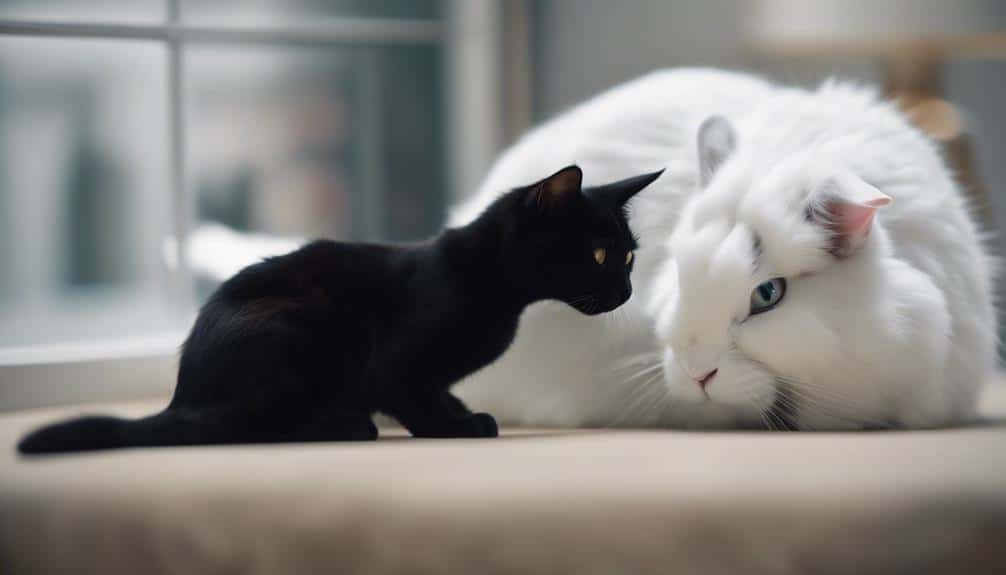
When cats and rabbits get together to groom and cuddle each other, it's a pretty strong sign that they've developed a bond of trust and companionship. It's really heartwarming to see these two species, which you wouldn't normally think would get along, showing each other affection and being comfortable around each other.
There are a few key things to note about this behavior. First, it helps build trust between the cat and rabbit. When they're grooming and cuddling each other, it shows that they feel safe and comfortable in each other's presence.
This behavior also helps create a sense of companionship between the two. It's like they're forming a strong friendship, despite being from different species.
Another benefit is that it can help reduce stress and anxiety in both the cat and rabbit. When they're engaging in mutual grooming and cuddling, it creates a calming environment that helps them relax.
Addressing Individual Personalities
Integrating cats and rabbits can be a challenge, but it all starts with understanding their individual personalities.
Each pet has its own unique traits, quirks, and characteristics that shape how they behave and interact with others.
When you bring a cat and a rabbit together, these individual personalities can either clash or mesh.
So, how do you ensure a harmonious coexistence?
The answer is simple: observe their behavior and how they interact with each other.
Personality Compatibility
When you're thinking about getting a cat and a rabbit to live together, it's super important to consider their individual personalities. You see, cats and rabbits are very different animals, and their personalities can clash if you're not careful.
For instance, if you have a shy or timid rabbit, it might feel threatened by a confident cat. This can lead to conflicts because the rabbit might feel scared or intimidated. On the other hand, if you have a confident rabbit, it might try to assert itself by chasing the cat to establish boundaries. But usually, this isn't done out of hostility.
Rabbits can also be pretty territorial, which means they might try to dominate the cat. So, you need to keep a close eye on them when they're interacting. And let's not forget that cats are natural predators, which means they might see the rabbit as prey.
This is why it's crucial to introduce them slowly and supervise them closely to ensure their safety and well-being.
Behavior Observation
When you're thinking about getting a cat and a rabbit to live together, it's really important to understand their individual personalities. To do this, you need to observe their behavior.
When you're introducing a rabbit to a cat, take your time and do it gradually. Let them get to know each other under your supervision. Start by letting the rabbit explore a safe space while the cat watches from a distance. Pay attention to the cat's body language – are they curious or aggressive? Also, watch how the rabbit reacts – are they scared or comfortable?
As they get more used to each other, observe how they approach each other. Look for signs that they're interested in each other, like gentle sniffing or playful behavior. But also be on the lookout for any signs of stress or hostility.
It's not a one-time thing, either. Keep an eye on how they interact even after they seem comfortable with each other. By paying close attention to their behavior, you can spot any potential problems and help them live together in harmony.
Setting Boundaries for Positive Interactions
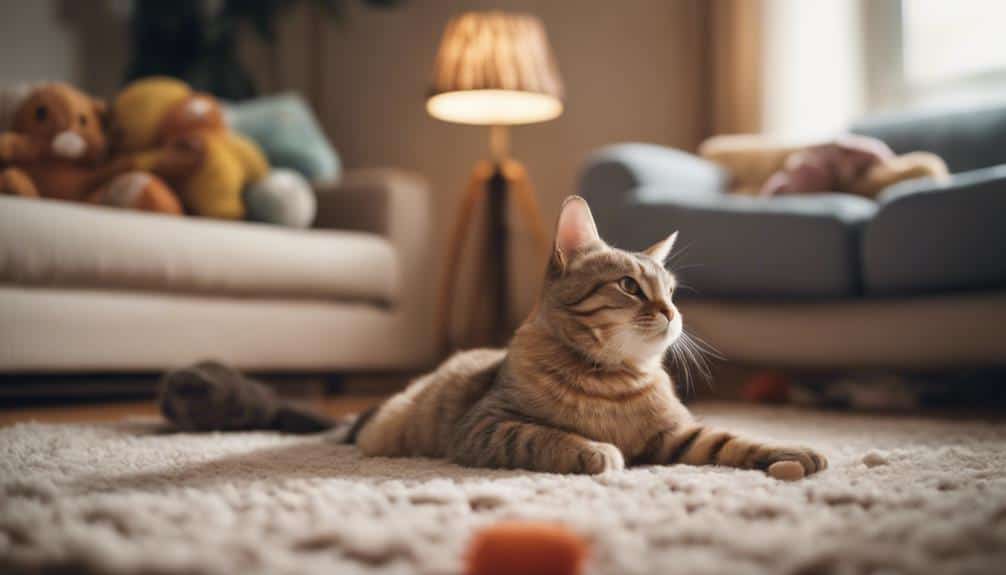
To ensure positive interactions between cats and rabbits, it's crucial to set clear boundaries so each animal feels safe and secure in their own space.
First, create safe zones for your rabbit. This could be an X-pen or a room that your cat can't get into, where your rabbit can retreat if it feels threatened or overwhelmed. This way, your rabbit has a place to go where it can feel safe and relaxed.
Next, provide elevated spaces for your cat. Give your cat access to high perches or separate rooms that your rabbit can't reach. This allows your cat to feel relaxed and secure, without feeling like it's competing with your rabbit for space.
Another important step is to implement physical barriers. When you're not around to supervise, use solid doors or barriers to separate your cat and rabbit. This prevents conflicts and maintains safety.
Enriching Lives Through Companionship
Building a strong bond between cats and rabbits can greatly enhance their well-being.
In fact, the House Rabbit Society found that 10% of cat-rabbit pairs develop close, loving relationships. The key to this companionship is socialization, which helps them recognize and respond to each other's vocalizations. Over time, cats learn to respect rabbits' boundaries and personal space, while rabbits can pick up on cat vocal cues.
When it comes to nurturing these relationships, a calm and peaceful environment is essential.
Take Adina and Rosina, for example – their bond led to mutual grooming and cuddling, enriching the lives of both pets and their owners. Then there's Toby and Moses, who show us how cats and rabbits can entertain and keep each other company.
Conclusion
Getting a cat and a rabbit to be friends is kind of like trying to get two very different people to dance together in perfect harmony.
It's not always easy, but if you understand their natural instincts, create a safe space for them to interact, and encourage positive interactions, you can help them develop a strong bond.
Think of it like a choreographed dance.
With patience and guidance, your cat and rabbit can learn to get along and even become great friends.
It might take some time and effort, but the end result can be a truly special relationship.

